It almost goes without saying: in some Indy neighborhoods, when a developer proposes a new project, a certain contingent immediately assembles to oppose it. We probably all know which neighborhoods these are. While an article that calls these opponents to the carpet will seem unfair (and, at least on an urban advocacy blog like this, all too commonplace), I hope I can at least offer a little bit of nuance and balance to the investigation, while still making the fundamental claim that the proposal in question is a good one—which, in turn, means that opposing it is, in my opinion, not a very good idea from a long-term neighborhood economic development standpoint.
The development in question is taking place on the edge of the Chatham Arch neighborhood. Kevin here at Urban Indy already covered it several weeks ago, and it generated a fair amount of positive discussion, as well as some vocal opposition. The project, taking place at the corner of 9th Street and East Street (predominantly fronting the latter of the two) involves a mixture of apartments, townhomes, single-family homes, and approximately 2,000 square feet of retail. The developer is a former resident of Indianapolis, who bought the property several years ago: a vacant charter school, surrounded by an unlocked chain-link fence, which, in turn has allowed it to serve as a de facto dog park, as Urban Indy pointed out.
A few weeks after our article, the Indianapolis Business Journal covered the Chatham Arch Neighborhood Association’s (CANA) overwhelming opposition to the proposal, with 26 rejecting and only 3 favoring it. The general consensus is that the proposal is too much density—that the five-story apartment buildings in particular would loom over neighboring single-family homes, that parking is already scarce, and that the appearance is completely out of character with the cottages that comprise the historic essence of Chatham Arch.  About this same time, the Urban Times monthly newsletter released a similar article, much more focused on the perspectives of the members of the Indianapolis Historic Preservation Commission (IHPC). The IHPC voiced little concern about the proposal’s density but acknowledged some potential problems with how well it would conform to the appearance of the surrounding homes. By early December, the IHPC opted for a continuance, after determining that the architect/developer had not satisfied all the changes to the site plan that it requested through a November preliminary review.
So here we are, awaiting the next IHPC consideration on January 4, with CANA re-affirming its profound opposition to this proposal. Meanwhile, the Renaissance Place Homeowners Association, whose district sits just to the southwest of this site, objects primarily to the proposal’s pursuit of a variance for reduced parking, “in light of growing parking problems in the area†(per the Urban Times article). In other words, the voice of the surrounding neighborhoods, as least as articulated through neighborhood associations, is that this proposal is an unwelcome intrusion.
But what is the historic essence of Chatham Arch? It includes some of the oldest surviving housing in the city, with a few homes and commercial buildings dating from shortly after the Civil War, though the development of the neighborhood seems to have peaked in the 1880s to 1910s. Most of the approximately 110 structures contributing to Chatham Arch’s status as a nationally registered historic district date from that window of time. An optimal block in Chatham Arch looks like this:
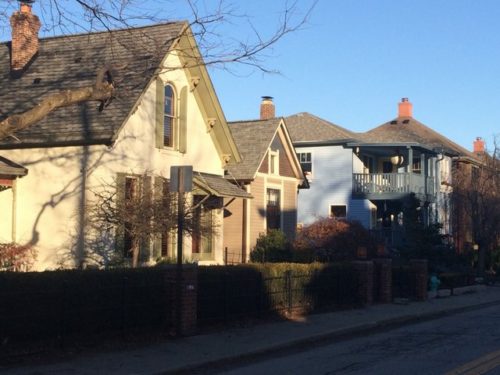
Or this:
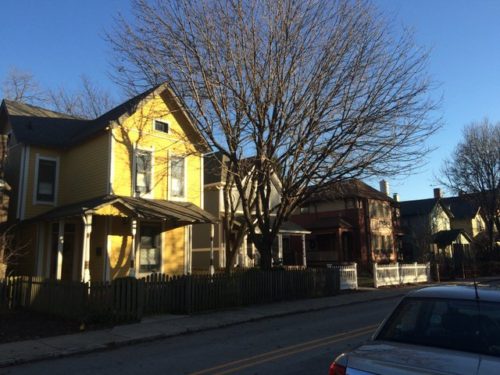
The neighborhood also features sporadic multifamily and commercial buildings.
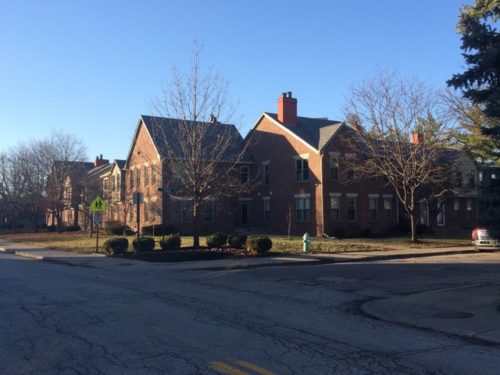
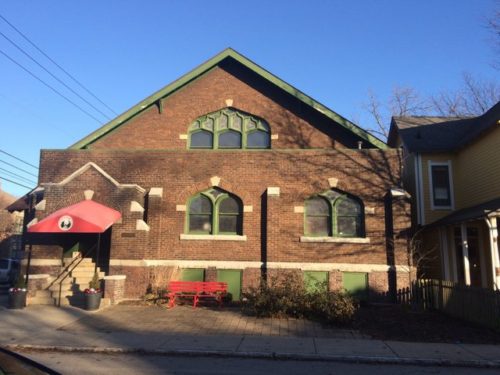
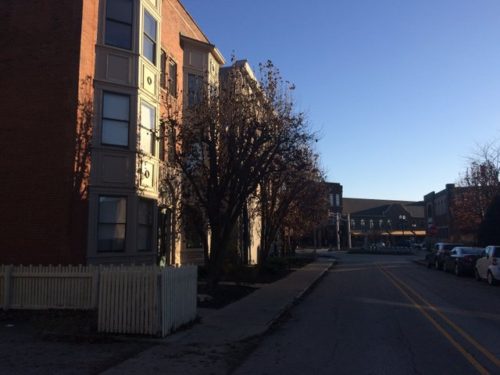
And, since it did grow over many decades, it should come as no surprise that the homes feature a variety of architectural styles, sizes and building materials.
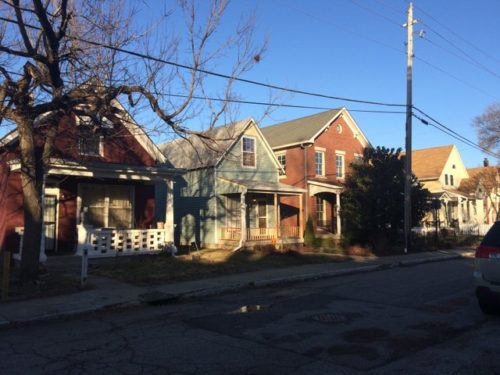
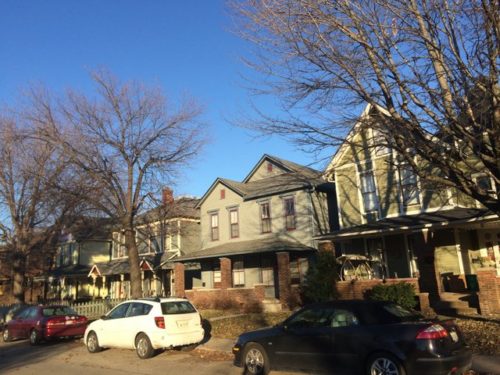
This tradition continues with the iterative infill from more recent decades—the era of Chatham Arch’s revival—which approaches contemporary design from a variety of interesting angles.
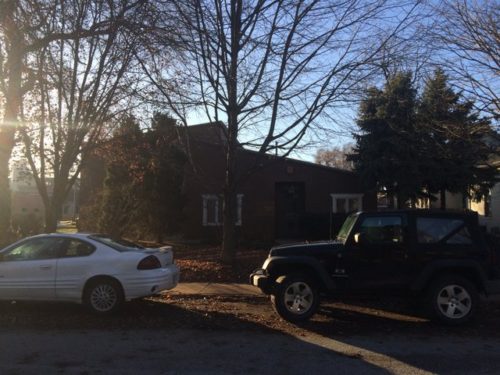
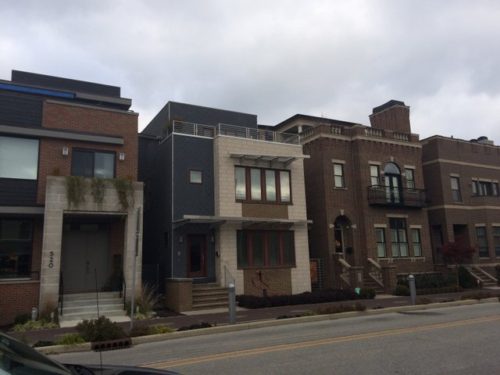
The modest appearance of many of the homes suggests that it never intended to be an enclave for the extreme wealthy. And, while it still doesn’t necessarily have the reputation of being a ritzy area per se, Chatham Arch commands some of the highest home values in the Indianapolis metro, at least when measured on a price-per-square-foot basis. Its strategic locations less than a mile from the city center and just blocks from Massachusetts Avenue has made it an extremely attractive location, and this desirability becomes manifest through steadily rising real estate values. (And many of the more recent homes are comparatively huge—sometimes twice as big as the historic neighbors.)
But is the area getting too big for its britches? That almost seems to be the implicit argument that CANA is posing: that the new development within Chatham Arch, and certainly in the less scrutinized blocks that surround it, is usurping the neighborhood of its original charm. And, as is almost always the case, the “density†argument rears its head. How dense is too dense? The developer with the proposal at 9th and East argued before the IHPC that Chatham Arch’s current density, at approximately 6,000 persons per square mile, is a far cry from the 20,000 persons a century ago, when the neighborhood burgeoned. Without confirming these numbers (it’s difficult determining how his Chatham Arch boundaries coincided with Census records from that time, when precinct or tract-based data lacked detail), he still made a compelling argument. After all, household size has been shrinking steadily for a century, which means these modest 1,000-square-foot homes, which today typically house only two or three people, probably used to shelter five or six. And if the number of people living in a typical house shrinks by 50%, it’s inevitable that the density in the overall neighborhood would shrink proportionally.
But that’s not it. An Indianapolis Sanborn map from 1887 shows exactly how tightly-packed the homes were back then.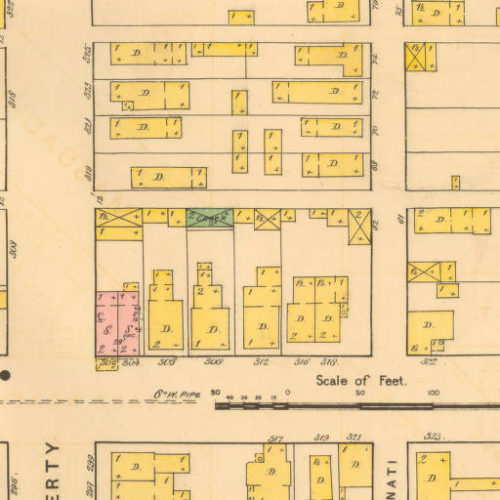
Virtually no parcels were more than 50 feet wide along their primary street frontage, and many were only 35’ wide. The rare parcels that exceeded 50 feet usually hosted twins. But today? My photos up to this point have captured some of the blocks in Chatham Arch that best preserve the density from 1890. Most, however, fall far short.
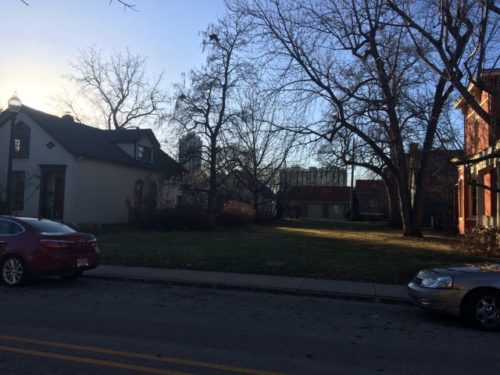
This yawning space between two homes probably serves as a side yard to one of the two, but it shows on Google Maps and those Sanborns as a discrete parcel—one that undoubtedly supported a home at one point. And these side yards are scattered throughout Chatham Arch.
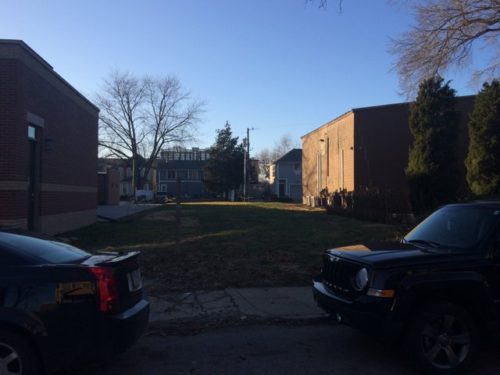
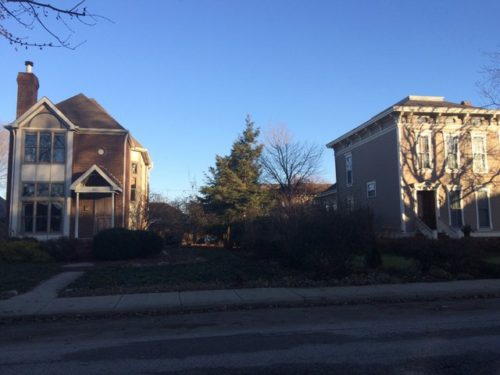
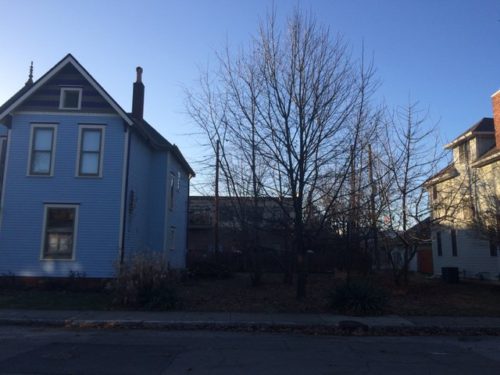
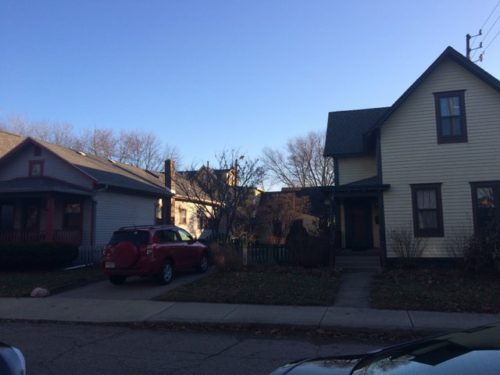
I will hand it to the current homeowners: in most cases, the curators of these side lots have done a marvelous job.
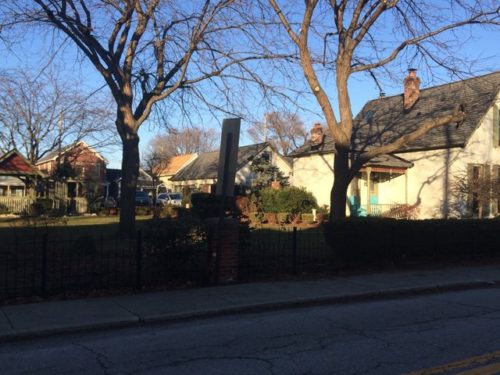
It’s a beautifully appointed garden, giving added texture to what otherwise would serve as a corner lot. And, in the residential market, corner lots are often the hardest to sell and lowest in value. But the side yard has also helped to make room for an enormous garage in the back alley, thereby essentially shutting out the prospect of the parcel getting developed.
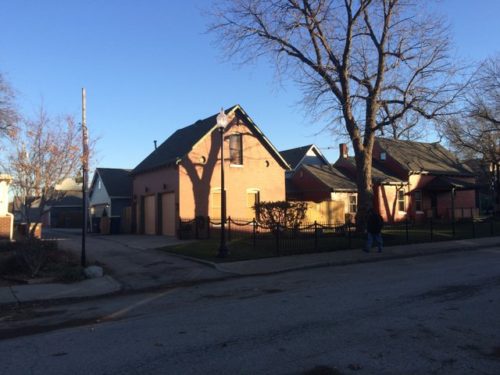
The homeowner who built this garage showed remarkable fidelity to the original architectural language, so it conforms nicely with the house and may even serve as a granny flat. But the odds are slim that this garage dates from the same era as the home, which almost definitely predates automobiles.
The net effect of all these side lots is an aggregate loss in population density. Here’s another where the former home serves as a parking lot to the business to in the far left of the photo.
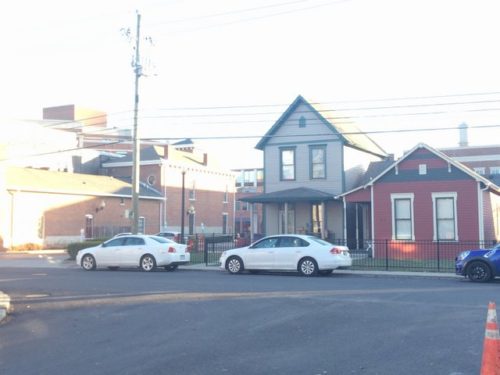
As a result of these side yards and the occasional parking lot, Chatham Arch, with an estimated density of 6,000, is simply average: high density for Indianapolis standards, but hardly on par with New York or Chicago, let alone many neighborhoods in older cities like Cincinnati or St. Louis. And its not evening within shooting range of its density from the time period where it once flourished—an era, we might assume, when the neighborhood’s biggest advocates would seek to re-affirm.
These observations strive to address one key underlying issue: the historic integrity that CANA and most other neighborhood associations strive to protect is predicated upon a highly precise chronological snapshot that the existing residents (and CANA members) themselves have cultivated. Such activism has its clear benefits: most likely it saved many structures from demolition when the neighborhood was still in decline in the 1970s. The advocates that eventually formed CANA helped save a district that now has achieved registration with the National Park Service. Perhaps a CANA in 1950 would have saved even more charming old homes, if it had existed. But we can’t allow alternative, speculation-based narratives to obfuscate our reconciliation of the reality at hand with the selective ideal. The anti-density arguments now are, in most respects, preventing Chatham Arch from achieving a recovery to the neighborhood’s conditions from its peak. The opponents want the charm, the “character†without the density. Given technological and household changes over the last century, I don’t expect Chatham Arch will ever again achieve 20,000 persons per square mile. But it’s not unreasonable to expect half that amount, given the development potential in the area—development that could, and should, resemble the type proposed at 9th and East.
Yet, time and time again, the remonstrators just won’t have it. When is dense too dense, and what time period are they trying to reinvent? The reality becomes clearer when we assess the vacant charter school parcel in question with its immediate surroundings, which I will do in the second half of this involved article. This article is getting too long, and my ideas are not yet fully formed…but they will be soon.  In the meantime, I hope and expect this article to generate good discussion. I’ll try to participate when I can, though long-distance travel over the next few days may keep me away.
And stay tuned for part two.
[Note: A robust collection of old Indianapolis Sanborn maps is available here.]
23 remonstraters out of a total of 6,000 people should not be a controlling argument that purports to represent a majority. You have to pay to vote on CANA issues and only 26 people show up because the organization does not show enough current value to the current resident population for people to participate. It did have relevance and has shown great work in the past, but the current organization is lacking substance. Why 23 people (many sharing households as spouses or partners) have a voice that is purported to reflect the majority is a misrepresentation of the facts because the poll is invalid.
I think it is important for the IHPC to consider the availability of a variety of housing choices so that options are available throughout a persons lifetime from early 20’s to retirement. The proposed project offers more housing and price options, does not go beyond historic density and is appropriate for being on the edge of the neighborhood on a major artery to downtown. I desire density, more walkable retail and services space, and various sales and rent options. My single opinion is equally as valid as the 23 NIMBY paid votes.
Thanks for your comments, Joe. You are definitely touching on issues that I will explore further in the second half of this article. It’s unfair for me to scrutinize the membership of CANA, but it does seem as though we hear the same half-dozen voices whenever remonstrations get press coverage.
Does the developer have no responsibility to get at least some consensus from CANA or should any developer in any neighborhood be allowed to build without neighborhood support? It depends on how city council views the development approval process. In most older Midwest cities, having this much opposition would be a nonstarter.
They don’t necessarily have that responsibility. However, they would have a heck of a time getting past IHPC which tends to lean heavily on NIM… er, neighbors to the development.
NIMBY culture is a harsh reality in low dense places like Indianapolis. It’s easy to say anything is better than an open parking lot as much as it is for these NA officials to discourage density. Proper, community oriented (mixed use, higher density) development just takes time in strong suburban markets.
Thanks for you comment–but “NIMBY culture” isn’t remotely unique or particularly strong in Indianapolis. It is just as prevalent in the Loop of Chicago, where NIMBYs try to stop new high-rises from blocking their views of Lake Michigan using the exact same verbiage (though sometimes different methods). It’s not even clear it’s strong in Chatham Arch, since many others have voiced their approval of this project. The culture does, however, seem to be particularly prevalent among the executive board of CANA.
I agree…NIMBYism is everywhere. But tower development blocking significant views of Lake Michigan in Chicago vs opposing the Red Line due to ‘parking issues & crime concerns’ in Indy are 2 completely different stories.
i think you mean indiana culture.
There is a fundamental question here.
Is there a presumption that the property owner (developer) must “prove” that his development is a good one, or is the presumption that the remonstrators must prove that it is unsuitable. In short, who has the burden of proof?
Perhaps this starting point is spelled out in the neighborhood plan? Or in the IHPC rules? Often news coverage highlights comments and questions by IHPC members without providing this context.
Considering that the IHPC voiced frustration that their initial requests were not fully met through the revised site plan, at this point it appears the burden is on the developer. This, of course, does not preclude imposing a similar burden on the remonstrators once the developer meets these IHPC expectations.
I think the term density in this project is really being misused. The biggest problem I personally have with this project is the height of the 5 story building. Drive down East st and you will see no structures taller than 2 stories, except of course Lugar tower and please don’t try to tell me that’s a positive contribution to the area. The developer has done himself no favors here in how he has doggedly ignored all input from others and continues to Submit half baked unfinished plans. Another big problem I see is the CBD2 zoning request which is completely incompatible with our master plan and the surrounding uses.
As far as name calling and complaints about having to pay a nominal $25 to be a voting member of CANA I am sort of baffled how this contributes to a positive civic discussion.
Yes some of us who have been here since the early 80s when this was a largely vacant run down neighborhood few people wanted to invest in are quite passionate about our feelings now that it’s really a hot area – largely due to our hard work and previous efforts to keep our vision of what our neighborhood should looK like alive- are likely to speak up repeatedly, and are not going away.
I love this neighborhood and have spent the greater part of my life trying to make it a better place, so that I think that more so than my $25 annual dues gives me the right to express my opinions about such profiteering proposals. This project isn’t about density it’s about greed.
Hi Shawn, thanks for your comments. Please review Joe’s statements from 12/31, which probably effectively capture why so many residents in Chatham Arch have decided that it isn’t even worth the $25 to become a voting member of CANA.
I will acknowledge, however, that Chatham Arch does not have close to 6,000 people–the number 6,000 only reflects the current estimated density levels, though it is only that high because Chatham Arch is a tiny, tiny neighborhood (probably only about a quarter of a square mile). 1,400 people in a quarter square mile roughly translates to 6,000 per square mile, which is still only average urban density in the US–and low-density by most other countries’ standards.
I think Joe’s comment is uninformed, and to be honest kind of brash in that he think his opinion is more valid than those who bother to come to the meetings and hear the pros and cons of a project before casting their vote, because, you know, its his opinion. All neighborhood associations have a small group of members or particularly active members. Its a busy life these days and most people just don’t have the time or inclination to become involved.
I still own a home at geist that will be on the market shortly. In the admirals we are forced to pay $450 per year to the association and still very few people actually show up for any meetings or are involved at all. To whine about a voluntary $25 annual dues is therefore hard for me to understand, and to be frank if one is unwilling to pay that in order to have his vote counted;then his vote should definitely not count in my opinion, which, by the way, is no more valid than anyone else’s.
In some districts downtown- at least 2 come to mind-only the board of directors gets to actually vote- more of a representative republic approach than a democracy. I prefer the CANA choice of democracy.
what is inappropriate is having structures NOT taller than 2 stories this close to downtown, sure they’re historic, so they get a pass, but it’s ludicrous for people to think that because a bunch of short buildings exist downtown that nothing should be taller than they are. It’s ridiculous and it’s strangling this city. If someone wants to live in a small town with little buildings there are a thousand options for that. You don’t need to live in Indy and strangle it with conservativeness.
From the Urban Times article, it’s a really tough competition between these two comments:
“Sally Spiers, president of the Chatham Arch Neighborhood Association, said she liked the design of the project, and I hope they find a place to put it where it belongs, in an urban area.” Apparently, three blocks from the Mile Square is not an “urban area.”
And from the IHPC member who believes downtown Indianapolis is at its best when it resembles downtown Brownsburg: “Commissioner Susan Williams said the five-story feature at the corner of East and 9th was too tall, despite the fact that it sits on a major thoroughfare. She said the three-story structures facing Park Avenue are also too tall for the context of the neighborhood. She expressed concern that those houses would be overpowered.”
Therefore, downtown Indy should be filled in with 2 story single family homes: A DREAM COME TRUE.
This sentiment is common in so many cities and I think it can be traced to a number of factors. These comments apply to almost any urban neighborhood but I think most should hold true for Chatham Arch.
As you note, people often fail to understand the historic density of historic neighborhoods. Even “single-family” dwelling units often contained more than one family or an extended family (mom, dad, some kids, a widowed sister and her kids, grandma, a boarder, a servant). Reviewing a series of households on census forms for any given neighborhood in 1880 or 1900 can prove very informative in this respect. It offers a remarkable contrast to neighborhoods where historic double houses have been combined to create a single large residence.
Another challenge is that today’s longest-term residents are likely the 1970s-1990s urban pioneers (who saw these neighborhoods when they were largely abandoned) or people who moved in after them (when the neighborhoods were still close to their historic low populations).
Baby Boomers and subsequent generations were mainly raised in the suburbs and often have no personal frame of reference for the density or mixed-use character of a pre-WW II urban neighborhood prior to suburban flight. The post-WW II development mindset also classified the defining characteristics of historic urban neighborhoods as negative: density, mixed housing options, mixed uses, mixed incomes, transit-oriented. Even those who have embraced the benefits and the appeal of living in an urban neighborhood today are stuck with some level of conditioning from their suburban upbringing. The huge garages and vacant lots functioning as side yards (to give “space”) make sense from a suburban perspective but are antithetical to the historic character of these types of neighborhoods.
The massive federal subsidies for suburban home ownership in the post-WW II period made owning the norm for the middle class, and many Baby Boomers have trouble understanding why young professionals prioritize quality of life (and renting) over owning a home.
These conditions contribute to a stigma against development other than single-family dwelling units. The urban pioneers fought against slumlords who operated substandard units, and that is often what first comes to mind when they hear “apartments”, especially if the development contains any affordable housing units. These residents are often ardent promoters and fierce defenders of their neighborhoods, so it is very important that they see how a proposed development furthers the revitalization that they helped to start.
Rather than being a source of transient, problem neighbors, compatibly-designed apartments are often the lure for the next generation of home buyers in these neighborhoods, providing affordable housing for young professionals and the employees of local businesses as well as opportunities for existing residents to age in place.
In many ways, this is a struggle against a late 20th century suburban lens applied to how a historic urban neighborhood “should” be rather than a historically-informed view of what it has been and how it could develop in a way that is sympathetic to its history and architecture. Residents of historic neighborhoods are often interested in the history of their home and neighborhood and have resources (like the IHPC historic district plans) that can give some information on the history and evolution of their neighborhood. Understanding history can go a long way in informing our present views.
Thanks for the thorough and thoughtful reply, Ben. You’ve found a balance that is still sympathetic to CANA’s original vision, and I think you’ve done a better job than I have at tracing how they got to where we are today. I articulate my concerns not because I feel CANA is worthless or that it hasn’t achieved a great deal, but its rigid definition of appropriate development could ultimately undercut its ability to achieve any development at all, when there are still plenty of opportunities to turn Chatham Arch achieve its full potential. Numerous remonstrations across Indy have succeeded, and the underdeveloped lots prove it: along the canal to the east of the Indiana History Center, the AT&T buildings in SoBro, and now (perhaps) this one.
As the CANA member who made the motion to oppose the CURRENT version of this development, I would like to add some facts to this discussion. As a member of CANA’s Urban Design Committee, I’m very much in favor of increasing the population density in the Mass Ave and College Ave area. I supported the project of town homes and two four-story flats on 10th Street, enthusiastically support the plans for redeveloping the Coke plant between College Ave, 10th Stret, and Mass Ave., and will support plans for a multi-storied condo at North Street and Park Ave. That tentive condo would be just yards from my own condo.
So why do I oppose the CURRENT plan for East and Nineth Street? Frankly, I don’t trust the developer. He has not been forthcoming with the neighborhood or the IHPC and his arrogance has created an atmosphere of distrust.
1). He originally asked our UDC to approve the removal of easements within his property without any discussion of the project itself, We refused to give him a blank check.
2). He then presented a plan for individual houses, town homes, and a five-story condo that ignored the historic neighborhood’s master plan and asked to be given six feet of the easement on the east side of the property.
3). Advised by both our UDC and the IHPC to come back with a plan more in tune with our master plan, he showed up with some revisions for the east side of the project. He pointed out his “compromises” and suggested that, if the five-story condo was not approved, he would build cheap apartments on the property.
4). He also asserted that the city and the neighborhood had to let him earn as much money from his investment as he was able. Replacing the condo with town homes was not feasible, he said, because there was no demand for such homes. We, of course, know that is false becaue the developer of the 10th Street condo (that I supported) recently asked the city to allow him to forgo the second condo and build town homes instead. The demand for his town homes, he told us, was much greater than for condos in his recently completed four-story building. Several of the UDC members were insulted by the arrogance of the East Street project. I was more amused than angered. He was obviously trying to negotiate by bullying us. I thought that we now knew that he still had not shown his final plan.
5) Several CANA residents were prepared to speak against the project at the next IHPC meeting when the developer was to show his latest modifications. When he showed up with no significant changes and then preceded to tell IHPC members that they weren’t capable of understanding his plans, those residents decided to remain quiet and let him hang himself.
Based on these developments, I decided to oppose the CURRENT version of the development plan. My bet is that eventually a plan will be approved for town homes and individual houses on the east side of the property and a multi-storied condo and town homes with some sort of retail on the west side. I also assume that there will be an attitude adjustment on the part of the developer.
Meanwhile, I will continue to support a high density development at the Coke plant on the east side of my neighborhood. I am impressed not only with the plans themselves but by that developer’s professionalism and genuine courtesy. My only objection so far is to including a fancy-dancy speciality grocery store in the development. I’d preference a very proletarian Super Target.
would you mind telling us who exactly the developer is? as well as the architect, i couldn’t find any tags on the renderings.
Hi Don, thanks for providing some balance to the CANA perspective. I hope you can remain involved and help achieve a suitable compromise–the press coverage of this issue generally suggests that all opposition is due almost exclusively to density. Based on the value of the land and the cost for demolishing the school building, a low-density project consisting of nothing but SFD is not going to be possible: the developer would bleed in the red and banks wouldn’t lend to it.
You guys all are seeming to miss the point that this is a historic district. I was always kind of disappointed that that city, in its quest to develop every parcel of land into the “city of the future”, only carved out small districts that had not been completely demolished during the 50’s and 60’s in the name of progress, to protect and preserve. There are vast areas land downtown where this project would fit in perfectly.
When one buys land in a historic district one buys something special and different, and one can either embrace that-or in the case of this inexperienced developer-fight it. this could be a wonderful and very profitable project of townhomes or high end single family homes and still provide a huge return for the developer.
The blog article recognizes multiple times that this is a historic district. But the “CANA choice of democracy” clearly articulates the CANA vision of what “historic” should look like, which fails to account for contemporary market pressures, or even what “historic” meant in 1910, when Chatham Arch was 3 times more dense than it currently is.
This developer is doing what all developers have to do to avoid going bankrupt: riding the tide of market demand. Clearly, CANA has no problem with modern infill homes: the neighborhood already has a few dozen of them. CANA also has no problem with side lots, despite the fact that this obviously impinges upon the historic accuracy of the neighborhood, per the original Sanborns. CANA has a problem with urban density. In the end, the developer has to build what will give it a return, and since land values are significantly greater than they were a decade ago, what might have been a suitable density for an ROI in 2007 is inadequate today. It’s the same predicament that the community faced at College and Kessler last year, and thanks to community opposition, no developers for the time being are willing to touch that parcel. And the neighborhood gets a cluster of vacant AT&T buildings at a key intersection to gaze upon.
Actually Milhaus development has succeeded where TWG failed at the AT&T property and has gotten a much better building approved.
any renderings out on that? googling provided nothing. only that ratio was the architect.
Thanks for the clarification Paul–I thought the Milhaus proposal got rejected by the community as well.
It looks like the folks in Meridian-Kessler are taking a cue from the prevailing mentality in Chatham Arch, and are taking on the density battle again.
http://www.ibj.com/articles/61948-neighbors-sue-to-block-23m-college-avenue-development
Bear in mind, the Milhaus proposal was a scaled-down version of what TWG offered, with considerable lower density (albeit greater retail in Milhaus).
On the other hand, historic districts are not supposed to be frozen in amber, either. Development patterns, living preferences, and (especially) the feasibility of high-end condo development have changed considerably since the CAMA (Chatham Arch-Mass Ave) Historic District plan was adopted in 2006…right at the end of the condo boom that saw the 707 E. North developers go broke.
It never fails to amaze me when people who own “move-up” properties in small and enclave historic areas oppose newer “entry level” housing that will bring people who will learn the charms and appreciate the neighborhood…and form a pool of buyers for their properties when they are ready to sell.
Look at Indianapolis’ perpetually-pricey old/historic neighborhoods like Irvington and Meridian Kessler. They have a wide range of price points for ownership and rentals, and once people move in they tend to move up in the same area. Houses do not linger long on the market, if they even reach the market. The diversity in price points is part of what makes the neighborhoods consistently desirable.
I agree that someone can expect something different, but that different is a sense of history in a neighborhood and respect for incremental development over time. This is the complete opposite of suburban development which is all about building cheaply, rapidly and being replaceable in 10-15 years time. Historic districts are not about remaining the same forever, it’s more about quality incremental changes that reflect the long history of a place. The current version of Chatham Arch only partially reflects its great history through mostly historic single family homes (which others have pointed out were closer to multi-family homes decades earlier). The larger mixed-use buildings that make a place truly desirable and livable because one can live, work and play in place, have long been torn down. We must not fear development, even large development next to shorter homes. We should fear and oppose cheap development that’s going to fall apart in 20 years. This proposal is not cheap – it’s one of the highest quality things being proposed around the entire downtown.
Take a look at a rapidly gentrifying neighborhood (a very historic one I might add and much older than Chatham Arch in Southwark, London, UK): https://www.pinterest.com/pin/537828380473429326/ Notice how they mix classic old buildings, contemporary modest buildings, and even sky scrapers together. This is one of the most desirable and hotest neighborhoods in all of London at the moment. Keeping it locked into its past of factories and short old buildings only would not have allowed it to boom with extremely high quality new development. I’m very familiar with this neighborhood because the company that I work for has its headquarters in the heart of this along the river Thames.
We need a lot more mixed-use with heavy emphasis on retail spaces on the bottom floor. Most retail in downtown Indy and surrounding neighborhoods is currently occupied by offices. They generally don’t belong on the first floor and greatly damage the walkability of neighborhoods by creating a second round of *sprawl* scattering retail that should be much more clustered around the center back out to cheaper areas. This is what we should oppose and not quality developments like this proposal with proper retail space on the bottom. I’m ok with this proposal being 3-5 stories but retail must be part of this development and it must be high quality.
well just have a look at the proposal on georgia street where it turns it’s back to maryland… i like the hotel. hate the parking garage, which is one of the worst ones i’ve seen.
Brick and mortar retail is not going to keep filling new commercial space since brick and mortar retail is a shrinking share of retail. I’ll argue that some of these ground floor frontages need to be local small health clubs and clinics, doctors and dentists, and daycare centers.
The reason there are offices in first-floor retail spaces in Indy is that no one else wants to be there. See: Hudson, Cosmopolitan, lower level spaces along the Canal Walk downtown.
I disagree with you and will add that this is all a chicken and an egg problem. You need everything that you said plus shops and restaurants on bottom floors. I’m not opposed to health clubs, clinics, doctors, dentists, etc being on the bottom floor. What I am generally against is straight office space that does nothing to active a street for the pedestrian and clears out after 5 PM. That will never bring the vibrancy and walkability that so many true urban neighborhoods need to have to be financially sustainable.
Just because we can’t picture this yet in Indy doesn’t mean it’s not possible. There are so many cities in Europe (and the US) that has street after street of constant retail on the bottoms and no common office spaces on the first floors. Indy used to have that before the fetish with cars decimated the true urban areas of our city.
I agree that density would be a necessary condition to activate street-level retail and retail-like activity. But it may not be sufficient, except in very limited areas of high density and high income where customers are not particularly income-constrained or price-sensitive. Manhattan, the Loop, Society Hill (Philadelphia)…probably not Indy.
Starting with Sears and A&P, then Kroger, KMart and Walmart, and now Amazon and Peapod, consolidation and technology have sucked the life out of everyday retail shopping in neighborhood stores.
Hoping to reverse it seems to me a vain hope…even the ancient cities of Europe have become heavily suburban. The outskirts of Rome and Naples along the motorways look very similar to the outskirts of LA and San Diego on the 5 Freeway.
Jim, I think you’re touching on a valid point, and there’s definitely something to be said about not populating street-level retail with the kind of service-oriented office uses that fundamentally don’t need big windows to flourish (e.g., law firms, architects, insurance, accounting). I even blogged about the topic here at UI a few years ago: https://urbanindy.com/2013/03/22/mass-ave-retail-vibrant-behind-those-venetian-blinds/ I flogged what I saw happening for the exact same reasons you are now. Fortunately, we’re witnessing incremental improvement in the repurposing of the Marott Building and the parking lot next to it.
Chris, though, has a powerful rebuttal in that we’re experiencing a sea change in how we acquire durable goods. Unfortunately, I think my 2013 article is already outdated and a little idealistic: the continued implosion of retail nationwide is making it harder to fill those storefront spaces (urban and suburban) with conventional “shops”. Case in point: my adopted home city of Allentown just yesterday (1/3/17) received word that two high-end women’s fashion boutiques were closing on the commercial, pedestrianized ArtsWalk downtown. Both had received ridiculously reduced leasing rates through a statewide tax incentive called the NIZ (Neighborhood Improvement Zone) to relocate there from a suburban lifestyle center. They are closing after little more than a year, after paying peanuts on rent, because, according to their owner “trends are heading toward online shopping”. I’m just waiting for how much longer before we hear about this year’s closures at Circle Centre. (Swarovski? Eddie Bauer?) Like Chris, I agree that we have to be content with small health clubs, clinics, spas, and of course the bars and restaurants, which at least do offer some of that vibrancy. Sales of perishable goods (i.e. mini-grocers) also seem to be doing fairly well.
Lastly, most planners learn quite early in the profession that they’ll get laughed out of the meeting room if they mythologize Europe. We simply don’t have the land use patterns that they do. In the US, it’s not uncommon for a late middle-aged couple to use a retirement bonus to buy a vacant corner parcel to develop a strip mall which they will use to help finance their grandchildren’s college education. I can’t imagine that happening in Europe, where most countries set rigid standards for infrastructure expansion, and then how the land can get used once expanded. No doubt they saw what happened post WWII while the US was suburbanizing ridiculously and didn’t want that–besides, they don’t have the room to expand.
Also, in terms of consumer electronics, Europe is generally a good 5-10 years behind the US. (Granted, we’re far behind Japan, but that’s another subject.) When I last visited Germany extensively in 2012, I saw a bookstore in any medium-sized downtown city…which was right on the heels of Borders’ bankruptcy in the US. The fact remains that Germans are, fundamentally, a bit old fashioned in that respect: I only saw one E-reader during my visit (already ubiquitous in the US), Germans tend to be more apprehensive about retail giants like Amazon or Walmart, and, frankly, they’re nostalgic over the town centers they often restored after the war, with strict regulations intended to promote main street retail and discourage it elsewhere. That culture doesn’t exist in the US, which is why our durable goods vendors are abandoning bricks-and-mortar…a problem compounded by the fact that we have always been the most oversupplied country in the world for retail. Chris is right: downtown retail is feeling the pinch, even in European cities, as they suburbanize. For every vibrant Paris and Amsterdam, there’s a hugely vacant Lisbon and Budapest–their historic centers are much, much worse than Indy, but then, their economies are terrible.
All these factors help explain why we have to accept that medium density projects still often struggle to find tenants (Trailside on Mass Ave, for example, took years to achieve more than 50% occupancy). Developers can go bankrupt when they don’t absorb their retail after such a long time. This is why we are witnessing the latest Milhaus mediocrities at three locations, which you rightfully criticized on IBJ. I just don’t know of any solution that wouldn’t corner a developer into doing something the market doesn’t support.
I have to agree with Eric: embrace the past for the sake of going bankrupt…or fight for something viable for today’s market
It seems the newer, modern townhomes that have been built in recent years and that bear little resemblence to the cottages of the late 1800s have already redefined the “historic” character of the neighborhood. In my opinion, permitting the proposed development to be built will provide a vibrancy to the area – a visual delight to the eyes. Visit other historic cities where the new and old peacefully coexist and you can see the results are not disastrous. The best example I have seen of this is in Montreal, where stone structures from the 1700s have additions of glass and steel – and the results evoke a sense of a city that comtinues to evolve.
One more thing then I will go away. Indianapolis is not New York or Chicago. The reason our urban neighborhoods are composed largely of single family homes is that we had land with few barriers- rivers that had to be bridged- mountains that had to be crossed, oceans, etc.- and face it most people would prefer- given the choice-to have a little land to call their own to garden, relax in, whatever.
This whole blog seems to focus on the fact that we need more density- a concept i agree with in the central business district (i hate surface parking lots) instead of what we really need QUALITY DESIGN. We have very few truly inspiring designs put forward here. While you all may applaud density of the Artistry or Circa projects I decry them for what they lack. QUALITY LIFE INSPIRING DESIGN.
I agree with you that Indy is not Chicago or New York. However, I have to disagree with you that Indy (especially prominent historic districts like CA) should try and be Brownsburg…or some generic representation of what you & many others view as ‘historical’. Increased population (higher density) makes a place more vibrant than building styles. Oh, BTW: increased population density will support better design & development in the future. So I would say you gave a choice: love living in a developing, vibrant downtown…or move to Geist.
Micah: I would also add to your answer as well as to Shawn Miller’s that quality of buildings and retail and the built environment are hugely important, but not only because they make a place more vibrant (which they do). It also makes a place financially sustainable which all of Indy is not. Yes we have ridiculously low taxes compared to the rest of US cities and yes we could stand to raise some more revenue to pay for public infrastructure maintenance first, but the real reason that Indy’s infrastructure is so crappy is because there’s not enough people living in a small enough area to pay for the amount of infrastructure that our city government has created. It’s as simple as that. We need more people living in less area using less infrastructure to live their daily lives. The most efficient and vibrant way to do that is by creating great places with quality stuff: buildings, parks, sidewalks, transit, bike lanes, art installations, retail of all kinds, etc. Building low density inherently means unsustainable in so many ways but the main one is financially. Strong Towns have done some studies of smaller cities in the US that are just as sprawled as Indy showing that current property taxes and other revenues only pay for about 30-40% of the infrastructure built. It’s no rocket science why this infrastructure is crumbling then and why it’s so much cheaper looking than your average large and small cities in Europe. We’ve done our best in the US and definitely in Indy to hollow out our cities and turn them into the suburban utopia that has turned out to be a massive mistake. Adding quality infill that allows a lot more people to live in the truly walkable areas that can walk to everything is the least costly and most financially sustainable approach we in Indy can take.
thank you. people don’t seem to understand that suburbanizing indianapolis will drive it towards a situation like detroit, where it has so much land area and such a low population that everything ends up suffering. Whereas dense cities are healthy cities.
Indeed and the harsh reality is Indy will either grasp this somewhat proactively or be forced to understand this financial reality with the chance that for our lifetime it’s too late and crumbles into irrelevance. I know many of us on this site are doing our best to guide and educate the local population and leadership on this reality. Keep it up!
Indianapolis is not brownsburg or ogilville either….
I believe the comments reflecting opposition based on perceived arrogance of the developer resulting in distrust speaks loudly to the lack of a merit based review of the project by some members of UDC and a few of the small 23 objectors. I don’t like the guy is not a valid reason to oppose a project. The CANA meeting is not the only source of information on the project. All of the information is public record at IHPC offices. So, don’t assume that not attending a meeting means everyone else is ignorant of the facts. Again, 23 people is a minority opinion and hardly reflects the Will of the neighborhood. Pay to vote is an intentional act to limit votes. Otherwise, why wouldn’t every resident be entitled to vote and be a member. Suburb NA dues are largely for maintenance of common grounds and the like and you are a member automatically and required to pay by deed restriction. It is not an apples to oranges comparison. What is CANA afraid of by allowing every resident to vote on development matters? The CANA Foundation has purportedly millions of assets (who knows exactly the amount any terms?) with the Jones Charitable Trust that allows for discretion to distribute assets for valid purposes and as a result where the neighborhood has more access to funds than most NA’s for neighborhood projects like street signs and block parties. If CANA showed value, they would most likely collect more than they do now with the few current members. However, the NIMBY’s might lose control. The result is an invisible fence that limits access to different walks of life and effectively limits diversity. Support to the five story corner is easier to put in perspective with Lugar Tower and considering the zoning for the SE corner being 8 or more stories. The neighborhood plan does allow this kind of development on the edge of C A, except the NIMBY’s define the edge as South and not West.
There are a handful of residents of Chatham Arch that like to bully their opinions and speak for the neighborhood. I assure you they are not the majority. Speaking out against these people makes for a more difficult existence. Most residents are too busy enjoying their urban neighborhood or working a traditional job to battle the politics of the self proclaimed gatekeepers. More progressive neighborhoods are catching up with Chatham Arch and will no doubt surpass them on all levels. Shawn Miller should be the one to move out of the hood, not those in favor of progress.
AMEN AMEN AMEN!!! I live in CA and you wouldn’t believe the reaction I received when I told a few of these people that are against the project, that I was for it.
Well Sorry I’m not leaving anytime soon, and to be frank I really don’t care a great deal what gets built on this parcel, but the people who live next to it do. I have never tried to bully or push my opinion on anyone in this area, but I do have a right to defend my neighborhood when its being unfairly attacked, which it is here.
I really don’t think CA has “lost density” particularly in the number of structures in CA. This theory is being put forward by the developer, and I plan to research that further-but pointing to a time when large single family homes had been divided into several apartments isn’t really a good time to point to. I sincerely doubt 6000 people (or even half that) ever lived in the confines of CA. If I point to the date I came into the neighborhood when it was largely vacant and every other house had been demolished then its far denser today than it was then.
I am aware I am not going to get a fair shake on this blog whose stated mission is to make Indy a dense city, which I largely agree with, but fine call me a nimby, tell me to leave the area, whatever floats your boat as you hide behind a fake name. Go for your millenial shout down. Knock your self out.
CA is not a nimby neighborhood. We had our meeting, those who were interested came and listened and spoke. the vote was taken. it wasn’t even close. sorry.
It is a fact that Chatham Arch has lost density compared to it’s historically heyday.
You can check the census records as it is available to the public if you are willing to take the time to process the information.
Furthermore, the historical density is NOT based on a supposed subdivision of homes into apartments. If you take time to check the Sanborn maps (available to the public), you will see that there were once about 30 individual single-family homes and duplexe units that sat on the current day nursery lot in Chatham Arch.
The historical family size at this time was 4.9 people (factual censusl information available to the public). Multiply 30 units by 4.9 people and you come up with 147 people that once lived on the same lot during Indianapolis’ historical heyday. This combination created the density which allowed Indianapolis to be one of the great cities of the time.
I have no issue with the suburbs. In fact, thats where I enjoyed the majority of my childhood. But we must have at least one real city in this great state of Indiana, so that we can enjoy the wonderful benefits that come with true urban centers.
It’s also simple human nature. We get accustomed to the way things have been. When significant change is proposed that will disrupt our way of experiencing something that matters to us, i.e. our daily environs, the default for many is to anticipate negative consequences.
And in tangible terms, let’s not completely ignore how much the presence or absence of noise and light can affect your quality of life in the most minute ways. It’s natural that some people want to preserve in some form the conditions that attracted them initially to a neighborhood or that they have come to value over time.
And we also have examples of development done not quite right,i.e., The Villagio, which can bolster one’s apprehension.
I think people holding different takes on a specific development benefit if they try to first appreciate others’ perspectives as legitimate rather than reacting with a kneejerk dismissal of them. Starting from a place of “help me understand why …” can go along way toward engendering goodwill … and progress. Quite a few developments in downtown neighborhoods have come to be widely valued after initial resistance and/or skepticism because of these types of conversations among residents, developers, IHPC, and others.
And bottom line, if some people indicate there is nothing you can do to change their mind, then you can quit trying to do so and simply move on.
Here is exactly what the Chatham Arch Mass Ave Historic District Plan says about this site:
“855, 901 and 919-921 N. East Street
· If these non-contributing structures should ever be demolished or lost, any redevelopment should start by researching the historic development on the site. New development may be higher density residential, such as townhouses, along East St. but should be lower density, single-family and two-family houses, along Park St. The reintroduction of alleyways is encouraged.”
Lots of room for interpretation there, when one looks across East St. and sees a 15-story apartment building.
Well said Harold, I completely agree. Keep sounding this message in all forums like this around Indy…it needs to be remembered.
Thanks for your comments, Harold, and it is important to “appreciate others’ perspectives” in all cases. And we certainly want to avoid a Villagio–probably the worst residential edifice in the last decade, behind only the One America Parking Garage overall. But who is doing the “kneejerk dismissal” here? That’s probably only a matter of perspective as well.
Bear in mind your argument for “noise and light” was exactly the sort of nuisance consideration that helped create Euclidean zoning, putting the separation of uses and unwalkable conditions that characterize approximately 90% of metro Indianapolis’s land area. Are you arguing that we should import that characteristic to what little in metro Indy can pass as mixed-use? The folks moving to an urban setting who expect complete peace and quiet at all times lead the rest of us to question what “attracted them initially to a neighborhood” in the first place. Wasn’t it economic stagnance that explained why they previously experienced no light and noise?
If there is “nothing you can do to change their mind”, then the logical outcome here is that this property will continue to sit with an abandoned school, which in time will become an eyesore. Just as I witnessed many years ago in New Orleans, it’s amazing how many times the opponents of development overtly seek blight over investment, simply because they can’t handle the nature of the proposed neighborhood change.
Great discussion and an important topic. One item that I think is important to note; the proposed plan does not include any apartments. Each unit will be built for sale, not for rent. In addition, there will be sufficient parking for each of the 56 units. Downtown Indianapolis has added over 3800 apartments in the last 5 years, with another 1600 under construction or soon to be breaking ground. The number of new to market homes available for purchase in the same geographic area is significantly less (think 200). The market on the whole and the sustainability component of product type is an important consideration to be made when evaluating the proposed development.
Thanks for this clarification, Catherine, which further undermines any assertion that these units will be “future tenements”. Not only will they be owner-occupied, but that should provide a layer of protection if we do end up reaching an apartment bubble in the years ahead.
I’ll tell you. It’s culture….
Neighborhoods get hungry and neighborhoods get full. If Chatham Arch has decided that it’s appetite is satiated then these developers are welcome to look over here in Holy Cross. We’re hungry, and would do anything to prevent any more of our land from getting paved over by Angie’s List.
Personal neighborhood promotion aside, it does appear to be a common trend to fight the “growing up” of Indianapolis. As a millennial, perhaps I don’t appreciate the streetscapes or historic densities as much as I should but I think if a developer is bringing something that isn’t painted orange or navy blue it is worth considering in 2017…
or east side of fountain square. i would love for something to push my meth addict neighbors out east of the railroad.
You know, this is a remarkably civil conversation on the merits of this development and issues around it. People have largely avoided being disagreeable or preachy and that is quite refreshing.
Completely agree on that Chris. That to me means we’re making some progress in Indy!
Just one question, for context: when we talk about density, does it refer to people or buildings? It seems one side uses the term to refer to population, which today is a third of what is was a century ago, while the other side appears to refer to the structures, and their mass and scale (i.e., density). Is one kind of density less acceptable than the other?
Move it to Nora!!
Density is code for minorities